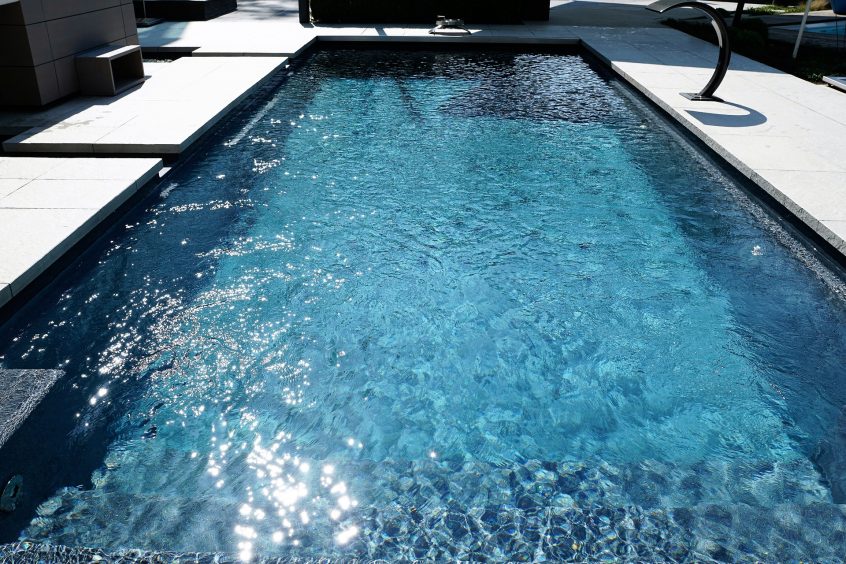Staining and water discoloration issues have plagued the appearance of swimming pools and hot tubs since the inception of the aquatics industry. These unsightly blemishes occur on pool and hot tub surfaces and can be a distraction from their desired appearance. They can be extremely frustrating, as well as difficult and expensive to remedy. Removing stains can be a complicated process which is often done incorrectly, resulting in wasted time and money, adding to the pool and/or hot tub owner’s frustration.
One of the main reasons why stains are so challenging to prevent and/or remove is because there is a great deal of confusion with regards to what actually causes them. For instance, metals, non-living organics, and even improper or poor techniques used in the construction of the pool all play a factor. In fact, these are all very different and all too common scenarios, which lead to the discolouration of underwater pool and/or hot tub surfaces. While this article will touch on many of these scenarios, the focus will be on the two most common causes of surface staining: metals and non-living organic stains. Further, exploring the specific remedies for these types of stains will shed some light on the issues, and hopefully eliminate the mystery and complications behind stain removal and prevention.
What exactly is a stain?

Figure 1: 1. Green Brown Stains; 2. Red Blue Stains; 3. Blue Green Black Stains; 4. Green Brown Red Stains; 5. Brown Black Purple Stains
A stain is a discoloration that can be clearly distinguished from the surface, material, or medium it is found upon. Stains are caused by the chemical or physical interaction of two dissimilar materials (e.g. acrylic steps and the tannins from leaves, or a metal substance such as copper [Cu]). Unfortunately, in a pool or hot tub, stains can be caused by a number of different things. Believe it or not, some forensics may likely be required to determine the type of stain and the best course of action to remove it.
Stain identification
Pool and hot tub surface stains can manifest themselves in different ways. For example, a swimming pool stain could be a mysterious dark blob that appears overnight, or it could show itself as an ominously slow shadow that plagues the pool like an unwelcome ghost. They can also appear in many different incarnations, varying in size, shape, location, color, and severity.
This litany of different manifestations and formations are two reasons why prevention and/or removal can be extremely confusing for the homeowner and professional alike. Using the stain categories shown in Figure 1 can help service professionals to better identify and treat stains that have developed on a pool or hot tub surface.
Green and brown

Stains that are green and brown are usually non-living organics and come from the tannins from leaves or other natural debris and often look like algae.
Green and brown stains, which appear on surfaces, are often caused by the tannins released from decaying plant debris and vegetation. Stains of this nature are classified as non-living organic stains.
Red and blue
These stains are also non-living organic in origin and more than likely caused by brightly colored berries; check the area around the pool and/or hot tub for a source of such vegetation.
Blue, green and black
When a stain is a mixture of dark blue, green, and black, and there is no evidence of non-living organic matter, the stain is likely to have been caused by one of the following: copper that has leeched out of the heater due to poor water chemistry, trace metals found in source water, and/or inappropriately applied products like copper algaecide.
Green, brown and red
This combination indicates iron (Fe) as the source of the stain. Iron oxidizes very easily—even with low levels of halogens in the water—and can even appear after the iron contaminated water is exposed to carbon dioxide (CO2).
Black and purple
This dark color combination is caused by manganese (Mn), another form of metal. Black discoloration can also be caused in plaster pools by black algae and should not be confused with a dark purple stain.
Non-living organic staining
| Stain color cheat sheet |
|---|
| • Green = Copper (Cu) • Red = Iron (Fe) • Yellow = Iron • Black = Iron, Manganese (Mn) • Brown = Iron, Calcium (Ca) • Grey = Calcium |
There are several different types of non-living organics that can end up leaving stains in swimming pools and hot tubs. As mentioned previously, stains that are green and brown are usually non-living organics and come from the tannins from leaves or other natural debris and often look like algae. For the most part, these are the easiest stains to eliminate.
Dark or reddish brown stains, which are typically metallic and generally stem from iron, copper or manganese, are somewhat harder to remove. A technique that works well for removing non-living organic stains is using the correct combination of chlorine (Cl) (elevate the level of chlorine to hit breakpoint) and scrubbing the area vigorously with a surface-appropriate brush. After 24 hours, add a concentrated form of a broad-spectrum enzyme as close to the discolored area as possible, and brush again. The tannins will degrade and the stain will fade to the point where it is virtually undetectable.
Sources of metals
Stains that are not caused by non-living organics can result from the untreated presence of heavy metals in the pool water. These heavy metals can occur naturally in water (especially in well water) or may have been introduced into the pool water as a result of corrosion caused by improper water chemistry. Some copper algaecides can be another source of metal staining. Quality copper algaecides, however, are usually in a chelated or stabilized form and normally are not a problem as long as they are used as directed.
The use of ionization products can result in the introduction of too much copper and can also result in staining and/or discoloration. However, due to their complex nature, it is unfortunate a ‘silver bullet’ does not actually exist for metal stains. Pool/hot tub stain and discoloration removal can only be accomplished by a process of using the proper materials combined with the appropriate techniques.
Frequent testing is a good way to stay on top of any metals that are finding their way into the pool. Small, trace amounts of metals in water will build up over time and can lead to the staining and discolouration of the surface. Keep in mind, it is possible to have a metal stain and little to no metal in the water. This phenomenon can sometimes occur due to the fact the majority of metals in the pool are actually concentrated on the surface (hence the stain) and are low to non-existent when tested. Should this occur, proceed with the topical vitamin C (ascorbic acid [C6H8O6]) test.
Stain identification

Using the vitamin C test, if the stain noticeably fades around the dissolving tablet it is confirmed to be metal in nature and can be lifted. If there is no reaction, the stain may be non-living organic.
The vitamin C test is a simple way to determine whether a stain has been caused by metals or non-living organics. This test involves placing a vitamin C tablet directly onto the stained area, and after a few minutes, if the stain noticeably fades around the dissolving vitamin C tablet, it is confirmed to be metal in nature and can be lifted. If there is no reaction, the stain may be non-living organic.
If the stain is suspected to be non-living organic, a small amount of sodium dichloroisocyanurate (NaDCC) (sodium dichlor) chlorine can be used to test it. This test involves applying a few ounces of sodium dichlor granules directly onto the stain (this may require some creative application methods, e.g. using a piece of polyvinyl chloride [PVC] pipe to apply the granules directly onto the stain, which has formed in the deep end of a swimming pool). Do not leave the sodium dichlor on the area for longer than one minute as a longer application may damage the pool surface with the effects of the chlorine. However, if a stain is non-living organic in nature, it will have faded significantly within 60 seconds.
Using the Langelier Saturation Index (LSI)
In addition to proactive testing (specifically targeting metals and hardness), the LSI should also be used to provide an even more detailed view of the pool water’s characteristics. The LSI is a calculated number used to predict the calcium carbonate (CaCO3) stability of water. It indicates whether water will precipitate, dissolve, or be in equilibrium with calcium carbonate. The LSI is expressed as the difference between the actual system pH and the saturation pH. For instance:
- If the LSI is negative, the water is undersaturated with calcium carbonate and will tend to be corrosive in the distribution system.
- If the LSI is positive, the water is over-saturated with calcium carbonate and will tend to deposit calcium carbonate forming scales in the distribution system.
- If the LSI is close to zero, the water is just saturated with calcium carbonate and will neither be strongly corrosive or scale forming.
Simply put, the LSI is a calculation that assesses the overall balance using the pH, alkalinity, calcium concentration, total dissolved solids (TDS), and water temperature of a water sample collected from the pool. There are many free online programs, as well as several mobile apps that utilize the LSI and are easy to use.
Discoloration from scale

Mold can grow so concentrated it actually shows through the liner and appears as a dark amoeba-like discoloration.
Often times, abnormal water discolouration can occur as a result of the formation of scale on pool or hot tub surfaces. Scaling is regularly misdiagnosed as a metal or non-living organic stain. The term scale refers to calcium carbonate. Calcium is a soft, gray alkaline earth metal, and is the fifth most abundant element in the Earth’s crust. When a pool or hot tub’s calcium levels are in excess and/or the water is out of balance for a period of time, calcium fuses with carbonates in the pool and hot tub water and a crystal-like structure forms.
This type of scale can alter the appearance of the pool and/or hot tub surface, and the resulting stain closely resembles a metal stain. The sense of touch can be used to determine if the stain is caused by a form of scale. If the discolored area feels rough like sandpaper, it is scale and the stain can be handled accordingly for removal. The vitamin C test earlier is also a good way to determine what may be altering the pool/hot tub’s appearance.
Other issues that can cause discolouration
- Blotchy or streaky gray discoloration that can develop during the first few months after completing a plaster swimming pool is called mottling. This type of discoloration is difficult to impact when removal is attempted and is often considered a ‘hydration problem’ or ‘entrapped moisture.’ This type of normal, dark discolouration should not be confused with metal or mineral staining;
- Improperly mixed color pigment;
- Variations in water content in batches of the finish coat;
- Excessive dry or moist spots (weepers);
- Trowel burn from improper troweling technique;
- Various surface coating thicknesses;
- Corrosion of structural rebar; and
- Mold under the liner. When a backyard’s water table becomes high, the excessive moisture trapped under the subsurface below a pool’s liner can become an ideal environment for black mold. This mold can grow so concentrated it actually shows through the liner and appears as a dark amoeba-like discolouration. Unfortunately, there is no effective method to removing this type of stain short of replacing the pool liner.
Tips to removing a metal stain
- Balance pool water chemistry before using any stain removal products. The water parameters should be as follows:
- pH: 7.2 to 7.6
- Alkalinity: 80 to 120 parts per million (ppm)
- Calcium hardness: 200 to 400 ppm
- Phosphate: Below 100 parts per billion (ppb)
- Before starting the stain removal process, a pulp-based filter aid is recommended in cartridge and sand filters. If a diatomaceous earth (DE) filter is being used, make sure it has been cleaned properly and recharged.
- Lower the chlorine level to (or below) 1 ppm. A high chlorine level or adding an oxidizer during the process can prevent the metals from being removed from the pool water, and the risk of re-staining is significantly raised.
- Add a quality stain removal product, and be sure to follow the manufacturer’s directions.
- After adding the stain removal product, brush the entire pool surface to ensure any metal particles that may still be clinging to the pool walls and floor will be displaced into solution.
- After brushing, add a quality sequestering agent. Be careful and aware that many of these types of products are phosphate-based, thus phosphate levels can increase during this process.
- Vacuum the entire pool thoroughly.
- After vacuuming, clean the filters thoroughly.
- Test and rebalance the pool water. It is a good idea to test the fill water at this time as well to determine if there are any trace amounts of metal in the source water. To prevent future staining, the weekly use of a non-phosphate sequestering agent is recommended.
- Do not super chlorinate or shock the pool for at least a week. As the chlorine will likely be low, it is best to bring the sanitizer level up slowly (e.g. 1 ppm per day for several days).
Testing and awareness
The key to the prevention and remedy of swimming pool and hot tub stains is testing and awareness. Be aware of the environmental factors of the pool and/or hot tub’s surroundings, as well as the quality of the fill water being used. It is also important to embrace and rely on more advanced testing methods that are now readily available—such as LSI—and know the details about the source water makeup.
Many metal issues are unknowingly created from tap water, and the necessary preventative measures are not taken. Last but not least, remember to brush the pool. The more the pool/hot tub is brushed, the less likely there will be any surface issues. By simply exercising a little more diligence and awareness, stains from metals and non-living organics can be easily avoided, allowing pool and hot tub surfaces to be better preserved.
This article was written by Chris Marcano and originally appeared on Pool & Spa Marketing [link].
